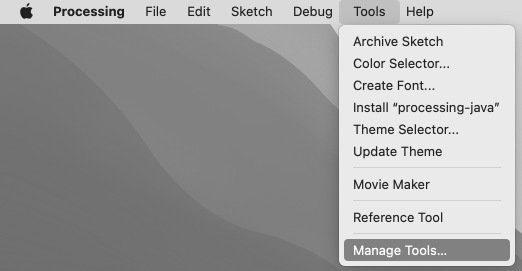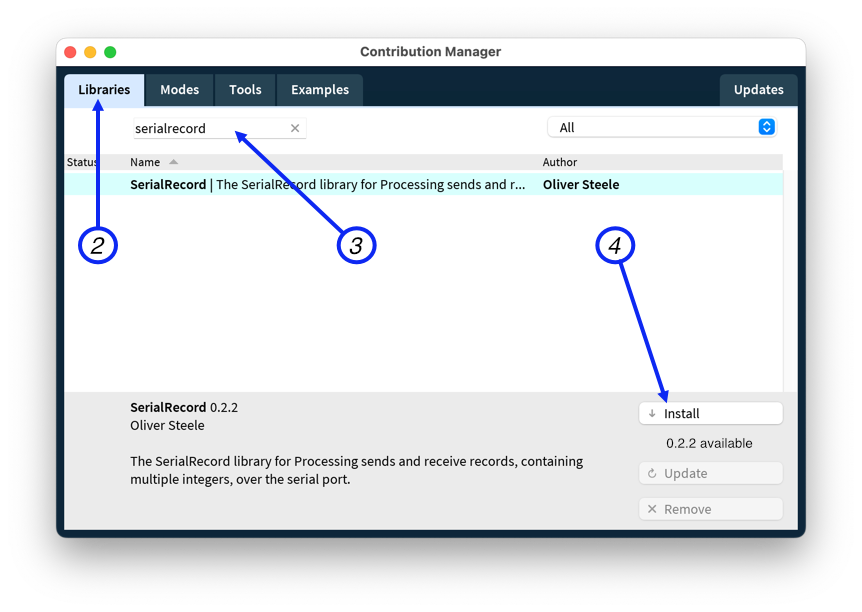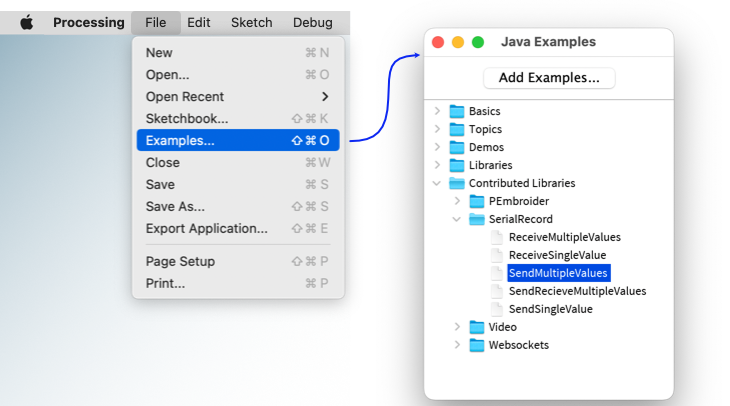Processing_SerialRecord
A Processing library for sending and receiving multiple-value records on the serial port.
Serial Record Library for Processing
The SerialRecord library for Processing sends and receive records, containing multiple integers, over the serial port. It is intended for novice programmers: it is designed to be easy to use, to detect when it is used incorrectly, and to detect and report when it receives invalid data. It also has an option to display the data sent to the and received from the serial port on the canvas.
The library also provides a function,
SerialUtils.findArduinoPort(), that attempts to find the
serial port that the Arduino is connected to. This can be used to write sketches
that do not need to be modified when they are run on another computer, or when
the Arduino is connected to another USB port. This function can be used
independently of the other functionality in this library.
Data is sent as comma-separated ASCII. This format is easy to view and interact with in the Arduino Serial Monitor, and is compatible with the Arduino Serial Plotter.
The Library can be used with the SerialRecord library for Arduino, but does not require it.

Design Goals
- Easy for novice programmers to configure and use
- Easy to inspect the transmitted data
- Detects and provides diagnostics for common errors
Non-goals
- Efficiency. The library uses an ASCII representation of numbers. This is easy to visually inspect without tools, but it is computationally expensive to read and write, and requires more bandwidth than a binary representation.
- Flexibility. All records must have the same number of values; only integers are supported. The first limitation make it possible to detect errors in code that uses the library, but is not appropriate to all communications. If you need more flexibility, this is not the library for you.
Features
- Parses sequences of integers separated by comma (CSV), tab (TSV), or space.
- Displays the most recent transmitted and received data on the canvas, as in the screenshot above. (See how to disable this..)
- Can be configured to log transmitted and receive data to the console. (See how to enable this..)
- Received records that have too few or too many values result in the display of a warning message on the console. This can help detect issues such a mismatch between the number of values that the Arduino sketch sends, and the number that the Processing sketch expects to receive.
- When used with the SerialRecord library for Arduino library, sending a different number of values than the code running on the Arduino expects, results in a warning in the Processing console. This can help detect issues such a mismatch between the number of values that the Processing sketch sends, and the number that the Arduino expects to receive. (See how this works, and how to make use of it in your own code.)
- Recognizes field names in records, e.g.
pot1:100,pot2:200. This is the format recognized by the Arduino Serial Plotter. - Provides a utility method that can in some circumstances (usually, on macOS) discover the name of the port that is used to communicate with the Arduino. This prevents someone running a sketch on a different computer than it was developed on, or when the Arduino is connected to a different USB port, from having to modify the source code to their sketches.
- When used with the SerialRecord library for Arduino library, a command can be used to request that the Arduino send back the values that it received, for debugging. This can be done once, or at periodic intervals.
Installation
Use Processing’s Contribution Manager to install this library:
- From the Processing IDE’s Tools menu, select Manage Tools….

- Select the Libraries tab.
- Search for “serialrecord”.
- Click Install.

Examples
Once the library has been installed, examples are available from the File > Examples menu.

Each example is designed to pair with an example in the SerialRecord library for Arduino library. However, the examples can also be used with other Arduino sketches (so long as those sketches are written to send or receive to expected number of values), or as a starting point for your own work.
The Examples wiki
page
describes the examples, and suggests which example from the SerialRecord
library for Arduino is intended for use with each Processing example. (For
example, the Processing SendSingleValue sketch was designed to pair with the
Arduino ReceiveSingleValue sketch.)
Troubleshooting
Some common problems and their solutions are described in the symptoms in Troubleshooting.
Code Recipes
The canvas display of the most-recently transmitted and received lines is helpful during initial development, but at some point you may require a canvas that contains only what your code explicitly draws there.
The Code Recipes Wiki page contains recipes to disable the feature where SerialRecord displays information on the canvas, and to log serial communication to the console instead.
Alternatives
It is relatively easy to transmit data between the Arduino and Processing without a library.
- Firmata, which features declarative binding of value positions to sensors or pin numbers.
- VSync Library for the Arduino platform “magically” synchronizes Arduino and Processing variables.
Acknowledgements
The idea of providing this code as a library was inspired by code provided to students by the NYU Shanghai IMA “Interaction Lab” course, for them to copy and paste into their sketches.
License
Copyright (C) 2020-2022 Oliver Steele. This software is made available under the terms of the GNU LGPL License.